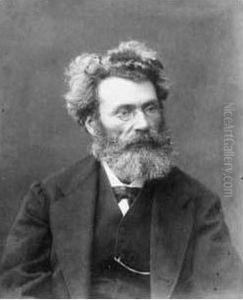Adolphe Goupil Paintings
Adolphe Goupil was a pivotal figure in the 19th-century art world, not as an artist, but as one of the most influential art dealers and publishers of his time. Born on January 13, 1806, in Paris, France, Goupil's impact on the art market and the dissemination of art was profound, shaping tastes and trends across Europe and America. His career began in earnest when he joined forces with Henri Rittner, a print publisher in Paris, in 1829, marking the start of a business that would eventually become Goupil & Cie, established formally in 1850.
Goupil's business acumen was unmatched; he expanded his operations beyond Paris, establishing branches in London, Brussels, The Hague, and eventually New York City. This international network allowed him to dominate the market for art prints, making works by leading artists of the day accessible to a broader audience than ever before. He was instrumental in the careers of many artists, promoting their work and producing high-quality reproductions that contributed significantly to their fame and financial success. Among these artists were Jean-Léon Gérôme, whose works Goupil reproduced and sold in large quantities, and Vincent van Gogh, whose uncle, Cent, worked for Goupil & Cie, bringing the young van Gogh into the fold for a time.
Goupil's influence extended beyond just the commercial. He was a taste-maker, helping to define the aesthetic preferences of the Victorian era. His firm specialized in the production of engravings, lithographs, and eventually photographic reproductions, which included a wide range of subjects, from classical and biblical scenes to contemporary life and landscapes. By the time of his retirement in 1867, Goupil had established a legacy that would endure, with his firm continuing to play a significant role in the art market until its eventual sale in 1921.
Adolphe Goupil passed away on May 9, 1893, but his contributions to the art world left an indelible mark. Through his efforts, art became more accessible to the masses, and the profession of art dealer was elevated to new heights. His vision for a global network of art commerce transformed how art was bought, sold, and appreciated, laying the groundwork for the modern art market.
